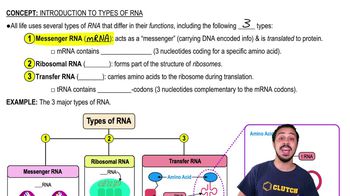Table of contents
- 1. Introduction to Biology2h 40m
- 2. Chemistry3h 40m
- 3. Water1h 26m
- 4. Biomolecules2h 23m
- 5. Cell Components2h 26m
- 6. The Membrane2h 31m
- 7. Energy and Metabolism2h 0m
- 8. Respiration2h 40m
- 9. Photosynthesis2h 49m
- 10. Cell Signaling59m
- 11. Cell Division2h 47m
- 12. Meiosis2h 0m
- 13. Mendelian Genetics4h 41m
- Introduction to Mendel's Experiments7m
- Genotype vs. Phenotype17m
- Punnett Squares13m
- Mendel's Experiments26m
- Mendel's Laws18m
- Monohybrid Crosses16m
- Test Crosses14m
- Dihybrid Crosses20m
- Punnett Square Probability26m
- Incomplete Dominance vs. Codominance20m
- Epistasis7m
- Non-Mendelian Genetics12m
- Pedigrees6m
- Autosomal Inheritance21m
- Sex-Linked Inheritance43m
- X-Inactivation9m
- 14. DNA Synthesis2h 27m
- 15. Gene Expression3h 20m
- 16. Regulation of Expression3h 31m
- Introduction to Regulation of Gene Expression13m
- Prokaryotic Gene Regulation via Operons27m
- The Lac Operon21m
- Glucose's Impact on Lac Operon25m
- The Trp Operon20m
- Review of the Lac Operon & Trp Operon11m
- Introduction to Eukaryotic Gene Regulation9m
- Eukaryotic Chromatin Modifications16m
- Eukaryotic Transcriptional Control22m
- Eukaryotic Post-Transcriptional Regulation28m
- Eukaryotic Post-Translational Regulation13m
- 17. Viruses37m
- 18. Biotechnology2h 58m
- 19. Genomics17m
- 20. Development1h 5m
- 21. Evolution3h 1m
- 22. Evolution of Populations3h 52m
- 23. Speciation1h 37m
- 24. History of Life on Earth2h 6m
- 25. Phylogeny2h 31m
- 26. Prokaryotes4h 59m
- 27. Protists1h 12m
- 28. Plants1h 22m
- 29. Fungi36m
- 30. Overview of Animals34m
- 31. Invertebrates1h 2m
- 32. Vertebrates50m
- 33. Plant Anatomy1h 3m
- 34. Vascular Plant Transport2m
- 35. Soil37m
- 36. Plant Reproduction47m
- 37. Plant Sensation and Response1h 9m
- 38. Animal Form and Function1h 19m
- 39. Digestive System10m
- 40. Circulatory System1h 57m
- 41. Immune System1h 12m
- 42. Osmoregulation and Excretion50m
- 43. Endocrine System4m
- 44. Animal Reproduction2m
- 45. Nervous System55m
- 46. Sensory Systems46m
- 47. Muscle Systems23m
- 48. Ecology3h 11m
- Introduction to Ecology20m
- Biogeography14m
- Earth's Climate Patterns50m
- Introduction to Terrestrial Biomes10m
- Terrestrial Biomes: Near Equator13m
- Terrestrial Biomes: Temperate Regions10m
- Terrestrial Biomes: Northern Regions15m
- Introduction to Aquatic Biomes27m
- Freshwater Aquatic Biomes14m
- Marine Aquatic Biomes13m
- 49. Animal Behavior28m
- 50. Population Ecology3h 41m
- Introduction to Population Ecology28m
- Population Sampling Methods23m
- Life History12m
- Population Demography17m
- Factors Limiting Population Growth14m
- Introduction to Population Growth Models22m
- Linear Population Growth6m
- Exponential Population Growth29m
- Logistic Population Growth32m
- r/K Selection10m
- The Human Population22m
- 51. Community Ecology2h 46m
- Introduction to Community Ecology2m
- Introduction to Community Interactions9m
- Community Interactions: Competition (-/-)38m
- Community Interactions: Exploitation (+/-)23m
- Community Interactions: Mutualism (+/+) & Commensalism (+/0)9m
- Community Structure35m
- Community Dynamics26m
- Geographic Impact on Communities21m
- 52. Ecosystems2h 36m
- 53. Conservation Biology24m
15. Gene Expression
Introduction to Types of RNA
Problem 3
Textbook Question
Textbook QuestionThe anticodon of a particular tRNA molecule is a. complementary to the corresponding mRNA codon. b. complementary to the corresponding triplet in rRNA. c. the part of tRNA that bonds to a specific amino acid. d. catalytic, making the tRNA a ribozyme.
 Verified step by step guidance
Verified step by step guidance1
Step 1: Understand the question. The question is asking about the anticodon of a tRNA molecule. The anticodon is a sequence of three nucleotides forming a unit of genetic code in a transfer RNA molecule, corresponding to a complementary codon in messenger RNA.
Step 2: Review the options. Option a suggests that the anticodon is complementary to the corresponding mRNA codon. Option b suggests that it is complementary to the corresponding triplet in rRNA. Option c suggests that the anticodon is the part of tRNA that bonds to a specific amino acid. Option d suggests that the anticodon is catalytic, making the tRNA a ribozyme.
Step 3: Recall the function of the anticodon. The anticodon of a tRNA molecule is a sequence of three nucleotides that is complementary to a codon in the mRNA. The anticodon recognizes and binds to the codon in the mRNA during protein synthesis.
Step 4: Match the function of the anticodon with the correct option. The anticodon is complementary to the corresponding mRNA codon, which matches with option a.
Step 5: Confirm the answer. The anticodon of a tRNA molecule is complementary to the corresponding mRNA codon, so the correct answer is option a.
Recommended similar problem, with video answer:
 Verified Solution
Verified SolutionThis video solution was recommended by our tutors as helpful for the problem above
Video duration:
48sPlay a video:
Was this helpful?
Key Concepts
Here are the essential concepts you must grasp in order to answer the question correctly.
Anticodon and Codon Interaction
The anticodon is a sequence of three nucleotides in tRNA that is complementary to a corresponding codon in mRNA. This interaction is crucial for the accurate translation of genetic information into proteins, as it ensures that the correct amino acid is added to the growing polypeptide chain during protein synthesis.
Recommended video:
Guided course

Interspecific Interactions
tRNA Function
Transfer RNA (tRNA) serves as the adapter molecule in protein synthesis, carrying specific amino acids to the ribosome. Each tRNA molecule has an anticodon that pairs with the mRNA codon, allowing it to deliver the appropriate amino acid for incorporation into the protein being synthesized.
Recommended video:
Guided course

Functional Groups
Ribosomes and rRNA
Ribosomes are cellular structures made of ribosomal RNA (rRNA) and proteins, where protein synthesis occurs. While rRNA plays a structural and catalytic role in the ribosome, it is distinct from the tRNA's function, which specifically involves matching anticodons to mRNA codons to ensure the correct amino acid sequence.
Recommended video:
Guided course

Ribosomes

 7:20m
7:20mWatch next
Master Introduction to Types of RNA with a bite sized video explanation from Jason Amores Sumpter
Start learningRelated Videos
Related Practice


